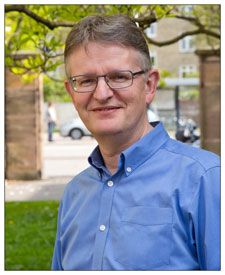Klaus Mosegaard new professor of geophysics - again
Klaus Mosegaard is a geophysicist and researches the Earth’s internal processes and the geological structure of the subsurface using mathematical modeling. These are research projects that he worked on at the Niels Bohr Institute until he chose to accept a professorship at DTU in 2010. Now he is back at the Niels Bohr Institute as professor and head of the research group Computational Geoscience.

Klaus Mosegaard is back at the Niels Bohr Institute as professor and head of the research group Computational Geoscience..
It’s wonderful to be back,” he says immediately. He has his entire research group of geophysicists, geologists, mathematicians and acousticians - bringing a total of eight people to the Niels Bohr Institute, where he has established the research group, Computational Geoscience. But even though the name suggests that they only work with mathematical modeling and theoretical problems, it is also very widely used research.
“It is very important to me that what we are working on has practical applications. In fact, about half of our work is research projects based on concrete problems, while the rest is basic research, where we, for example, try to throw light on the inner structure of the Earth,” explains Klaus Mosegaard.
Investigating the hidden world
In geophysics, you have the particular problem that you can only examine the uppermost layers directly, so in order to study the Earth’s interior, you have to make advanced geophysical and statistical calculations of the hidden world. Klaus Mosegaard is an expert in these kinds of calculations. By starting with an effect, he can calculate its cause. This could be, for example, creating an image of the Earth’s interior using data from a large earthquake. You only have hazy images, he explains, and they would like to go a step further and use their knowledge of the relationship between pressure, temperature, minerals, etc. to form a clearer tomographic picture of the Earth’s complex internal structure and its chaotic processes.
“Using seismic surveys and modeling techniques, we can help find oil and gas deposits in the Earth’s complex and messy structure of layers and we are working to find suitable areas where you would be able to store energy from wind turbines by heating water and pumping it down to suitable deep reservoirs where it can maintain its temperature and then you retrieve it when you need the energy,” explains Klaus Mosegaard, adding that all calculations are firmly based on physics and mathematics.
The group has several exciting research projects where they are trying to map the subsurface and discover how geological structures are created using mathematical models.
